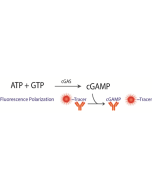Cookie Policy: This site uses cookies to improve your experience. You can find out more about our use of cookies in our Privacy Policy. By continuing to browse this site you agree to our use of cookies.
BellBrook
cGAS (human) (rec.) (His) (Active) (10µg)

| Product Details | |
|---|---|
| Synonyms | Cyclic GMP-AMP Synthase; Mab-21 Domain-containing Protein 1 |
| Product Type | Protein |
| Properties | |
| Source/Host | E. coli |
| Sequence |
Full-length human cyclic GMP-AMP synthase enzyme (cGAS enzyme) fused to a His-tag. |
| Crossreactivity | Human |
| Application |
For use with cGAS activity assays. |
| Biological Activity |
For the specific activity please refer to the Certificate of Analysis for each individual enzyme lot. |
| Purity | ≥90% (SDS-PAGE) |
| Accession Number | Q8N884 |
| Formulation | Liquid. In 20mM Tris 7.5, 200mM NaCl, 1mM DTT, 10% glycerol buffer. |
| Other Product Data |
Uniprot Q8N884: cGAS (human) |
| Shipping and Handling | |
| Shipping | DRY ICE |
| Short Term Storage | -20°C |
| Long Term Storage | -80°C |
| Handling Advice | Avoid freeze/thaw cycles. |
| Use/Stability | Stable for at least 6 months after receipt when stored at -80°C. |
| Documents | |
| Product Specification Sheet | |
| Datasheet |
 Download PDF Download PDF |
Cyclic GMP-AMP (cGAMP) synthase (cGAS) is a nucleotidyltransferase located in the cytosol that acts as a cytosolic DNA sensor to detect foreign DNA from microbial pathogens as part of the innate immune response. Upon binding to cytosolic DNA, cGAS produces the cyclic dinucleotide second messenger cGAMP, which activates stimulator of interferon genes (STING), leading to activation of the type I interferon (IFN) pathway. In vitro, fibroblasts, macrophages, and dendritic cells isolated from cGAS knockout (cGAS-/-) mice do not produce type I IFNs following DNA transfection or DNA virus infection. Similarly, cells containing a frame-shift mutation in the cGAS locus fail to mount an immune response to HIV and other retroviruses. In vivo, cGAS-/- mice infected with herpes simplex virus 1 (HSV-1) have lower levels of IFN-α and IFN-β, shorter survival times, and higher post-mortem levels of HSV-1 in the brain. This enzyme is for use with cGAS activity assays.
- Recognition of Cytosolic DNA by cGAS and other STING-dependent sensors: N. Bhat & K.A. Fitzgerald; Eur. J. Immunol. 44, 634 (2014) (Review)







